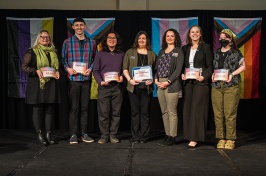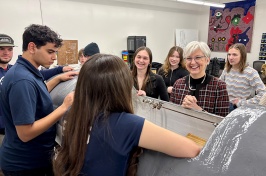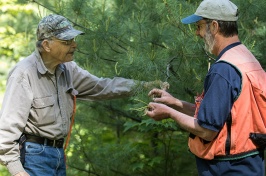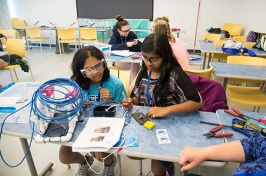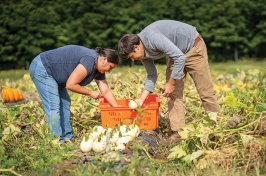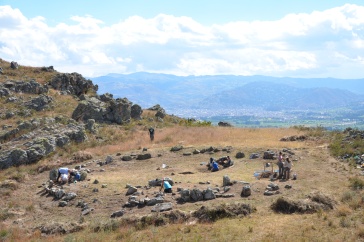Pr Peshkova is interviewed by the Central Asian Analytical Network (CAAN). Her interview is made available to both the Russian and English speaking community. (for English use the toggle above her photo) English version is below. Click here to access the full article.
American women haму recently shown a great involvement into political activism by one contesting the highest post in the US and some protesting the presidency of Donald Trump. During the Women’s March on Washington DC after the Trump’s inauguration, women worldwide showed their support to Americans. CAAN’s first question from Professor Svetlana Peshkova was about the reasons why Central Asian women did not march to support American women and does it tell about impossibility of political gatherings in Central Asia or lack of attention of our women to global political trends?
Dr. Peshkova is a socio-cultural anthropologist, ethnographer, and a scholar of Islam and gender. She is the acting Chair of the Department of Anthropology at the University of New Hampshire, the USA, and a part of Women’s Studies Program at the same school. Her recent book (2014) is titled «Women, Islam, and Identity: Public Life in Private Spaces in Uzbekistan,» published by Syracuse University Press (NY, USA).
Svetlana Peshkova: I want to begin answering with a question, «Why should Central Asian women follow this or any other trend»? We are all unique individuals and do not have to be measured by the same measuring stick. Also, an absence of evidence does not mean negative evidence.
There could have been supporting rallies, or pickets, but we do not yet know about them. Recently, I had an opportunity to speak with Gulya Maksat, a representative of Bishkek Feminist Initiatives, who told me that the group had a discussion whether or not support the Women’s March in Washington. Because of the recent tragedy, a plane crash near Bishkek on the 16th of January that has destroyed buildings and killed dozens of people, it was decided that their communities would be better served by putting all efforts in rescue and emotional support of local people. Yet some activists in Bishkek still went on a “stroll” of support of Women’s March in Washington.
Even though I am not a Central Asian woman, my Soviet heritage of growing up in the Caucasus, which is more important than my current research interests, might help me to ponder your questions. My answer has two parts.
First, there is no ONE reason behind what you refer to as a lack of attention on the part of local women to the Women’s March in Washington. A very limited space for civic participation might be one of the reasons. In order for a group of individuals to hold a sizable political rally or march in Central Asia, they have to apply for permission from government agencies, which probably will be denied. Further, women’s political activism has been and continues to be openly persecuted by law enforcement agencies and presented as an aberration to local conceptions of proper gendered behavior. One recent example is public condemnations of some women’s protests, often pejoratively referred to as “OBON,” in Kyrgyzstan. And yet, a lack of space and local mores did not stop women from protesting, such as when they had experienced a lack of gas and electricity, unlawful persecution, or when their relatives have been given long prison sentences in, for example, Uzbekistan.
I think that socio-cultural differences might be another part of the reason. By no means do I want to advance “culture talk;” “culture” is not a single explanation of human behavior. But, discourses on rights, particularly gendered rights, are very politicized and, hence, very sensitive in Central Asian countries.
In Central Asia, like in Russia, any discourse on rights continues to be (re)presented in the mass media as something “foreign,” “Western,” and “alien” to local “traditions.” Discourse on rights becomes even more sensitive and alienating when it comes to gendered rights, such as the rights of the LGBQTA and trans-people, and the rights of prisoners, prostitutes’ and disabled individuals’ rights, that too were a part of the Women’s March. These populations are often demonized in post-Soviet space, and Central Asia is no exception.
If local women are less preoccupied with political global trends, it is because they face not remote but immediate existential problems, such as how to make a living, what to feed their children with, and how to give their kids an education so that they can find a job locally. Additionally, they have social obligations toward their extended families (e.g., as a grandmother or a daughter-in-law) and ritual obligations toward their communities (e.g., wedding celebration). This is one part of the answer.
The second part of the answer is that we should not assume that one’s desires for social change, agency, and political activism are connected to liberal progressive agenda only. These desires, agency, and activism (the way to actualize these desires) are contextual. In Central Asia, like everywhere, women’s political participation or a lack of thereof are informed by complex socio-historical processes and are forged through a specific mutual constitution of individual existential concerns, religious sensibilities, post-Soviet social history in its local iterations, class aspirations, education, family upbringing and so on. To simplify, while some local women desire to have a right to work, others desire to be liberated from wage labor, in order to enjoy their wifehood and motherhood fully. In post-Soviet context, there is a flow of discourses on rights and obligations that make various configurations possible; here women’s rights may not be inimical to male dominance, existing understandings of equality may not clash with social gendered hierarchy, and family values continue to be paramount despite divorces, economic hardships, and gendered violence.
Local women are not passive; their political activism in all spheres of life, including public political activism, the leadership of local communities, and family leadership, are well documented. They have their own gender struggles and address these struggles on their own terms, prioritizing what is more and what is less important at the time. In terms of Women’s March on Washington, their lack of marching with or proclaiming their support of the event should not be taken as a lack of political activism either.
You assert that women in Central Asia are enough active in politics despite the civil freedom challenges and cultural specifics in their countries. When it is related to freedom of their husbands and sons or to social problems, the voice of women is louder than men’s, because they hope police will treat women protesters less harsh than men. But how about the civil activism? Can we have any bright examples, such as oppositional activities and further presidency of Rosa Otunbaeva in Kyrgyzstan and Oynihol Bobonazarova’s attempt to run for the presidency in Tajikistan?
The area of women’s socio-political activism is where “experience” should come before “expertise.” Local political activists, such as Bishkek Feminist Initiatives, can provide better, more detailed and up-to-date, answers to your questions. I am, by no means, an expert on Central Asian women’s activism, and hence, I can contribute only marginally to the answer.
First, I disagree with your assumptions behind these questions that political activism is/should be limited to one’s engagement with the state; that somehow daily needs are not part and parcel of political participation. From experience and historical facts, we know, that it is daily needs and rights to shelter, security and safety, mobility, water, gas and electricity, jobs, and so on that are the driving force of political activism and participation. These needs and rights, or a lack of thereof, can lead to public protests and participation in elections. These needs and rights can also be addressed through other kinds of politics — contextual politics. I agree with Hanna Arendt who reminds that “politics” comes from a Greek word polis, which “the organization of the people as it arises out of acting and speaking together,” and “plurality is specifically the condition . . . of all political life” (The Human Condition, University of Chicago Press, p. 198, 7).
Personal transformation and work of Hafizaopa Nasrulloh, who called herself an Islamist and traditionalist (d. 2003), is an example. I have described and discussed her life in “Post-Soviet Subject in Uzbekistan: Islam, Rights, Gender and Other Desires” (2013, Women’s Studies: an Interdisciplinary Journal, 42 (6):1-29). She started as a participant and supporter of Erk and Birlik, oppositional to the existing government movements in Uzbekistan), in the early 1990s. Disappointed by their lack of interest in women’s issues she moved on to join the Women’s Committee under President Karimov for a couple of years. Disillusioned with the state’s lack of interest in advancing women’s issues, in the late 1990s, she founded an online journal, whereas an online activist, she wrote about women’s rights in Islam, focusing on individual spiritual transformation as a necessary prerequisite for social change. She continued writing into the last years of her life. Often criticized for her traditionalist views by her peers, Hafizaopa’s views acquired a following both in Tashkent and in the Ferghana Valley. Some local religious leaders (otinlar), I write about, exemplify such politics as well.
There are also politics of collective action and contention that become the main impetus for social change. These might be applied to revoliutsioner katyndar(revolutionary women) in Kyrgyzstan, or groups of elder local women, who are often referred to as OBON, as discussed by a scholar, Elmira Satybaldieva personal communications, Jan. 2017, and her 2010 dissertation “The Nature of Local Politics in Rural Kyrgyzstan”, University of Kent).
OBON is a pejorative and very loosely used term. Not only women, but also young adults including young men become a part of the protests/activities that often labeled as OBON (see a report by Ajgul Aleimkulova, etc. 2012, Obon kak «zerkalo..,» Tsentr pomozhi zhenshinam, Bishkek, Kyrgyzstan). Many of the women who participate have genuine grievances. They act as a group through the means that are available to them; means that some may consider unacceptable. For some participants, financial incentives might be the main reasons to engage in these contentious collective actions; for others – it is corruption and lawlessness of the ruling elites, or personal frustration with a state that does not work; for yet others, it is a desire to be a leader and desire for actual social change. Since, as I have suggested previously, politics are not limited to liberal progressive agenda, which often has liberatory and modernist undertones (e.g., rights, education, equality, etc.), these women’s (and men’s) activism is as political as any other.
There are also symbolic politics. For example, Elena Urlaeva and Adelaida Kim’s flowers action commemorating Andijon victims at the Tashkent’s Monument of Courage in 2013. Both activists were arrested. But their action has succeeded. Their reminder of the bloody massacre was covered in the news, albeit not local in Uzbekistan, and Human Rights Watch later documented it in their 2014 report. Self-immolation is another example of symbolic politics of protest – a protest against the unjust world, in which one became completely disposable through a systematic domestic physical and psychological abuse.
There are other politics — one can call them “performative geographies” — which help to build space for and a sense of common language for political participation. One example is Bishkek Feminist Initiatives’ socio-political activism that, in some cases, is expressed through art installations.
Second, your questions seem to limit the value of women’s political activism to particular individuals. Certainly, such public figures as Rosa Otunbaeva or human rights activists, such as Elena Urlaeva, Mutabar Tajibayeva, and Malakhot Jeshankulova are very important socio-political figures. Yet, they should not be taken as the only valid examples of Central Asian women’s political activism. There are plenty of other examples where women participants are often unnamed. These include women’s struggle for rights at the brink of the 20th century, in the context of Jadids’ reform discourses before the revolution in Russia, and women’s activism in the 1920s and throughout the Soviet times.
Central Asian women’s political and civic activism was not limited to participation in hujum [the unveiling campaign] and included protests, sometimes violent, against the unveiling. Douglas Northrop (2004) book, Veiled Empire provides some of the examples.
Women’s presidency over local water committees across different Soviet Uzbek and Kyrgyz villages in the Ferghana Valley created networks of activism, while various women’s NGOs in post-Soviet Uzbekistan continue resisting the state’s heavy-handed control of their activities. Another example is women’s participation in the 2005 protest in Andijon, which resulted in a bloody massacre perpetuated by the state’s military. Particularly noteworthy and compelling was a silent protest by mothers during the trial of local businessmen (see a documentary film, Through the Looking Glass, produced by Monica Whitlock in 2010).
There are plenty of examples of women addressing critical contemporary issues, including, the late 2000s and 2010s, women’s protests/demonstrations against legalizing polygyny (having multiple wives) and bride kidnapping in Kyrgyzstan. (Some female state officials, like Ainura Altybaeva, were also active in addressing this issue). These examples also include women’s Internet activism documenting human rights abuses and information campaigns against forced sterilization in Uzbekistan.
Hence, there are plenty of female political actors, not limited to public individuals, in Central Asia.
You’ve noted OBON’s actions in Kyrgyzstan. Mainly, these women were used against the opposition and it is hard to name them as the real political actors. Something similar happened in Tajikistan too. The opposition representatives believed that the authorities forced these women to carry out those actions. Why women? I understand that students were also used, but taking into account the cultural frames of the women’s role in the region, why they were used for political reasons?
I disagree with your definition of political actors. First, as I had just argued, these women are very much political actors. Second, research shows that participants of contentious politics that are referred to by a pejorative OBON or Women’s Special Task Force (WSTF) are not limited to women. Third, “women” is such a broad category. Among these women, who come from different walks of life, some are trying to escape poverty. Others lost prestigious jobs. Yet others are barely surviving financially on their meager pensions. These different women (and men) all have different reasons for participating in contentious collective actions. These participants’ individual motivations and desires can only be discovered through experience and interaction and should not be assumed.
Some of these women see themselves as leaders; others think they are contributing to building a more just society, yet others participate because of financial remunerations for their performative expertise (e.g., screaming, cursing, etc.). Note, that despite these different motivations all use the means available to them, be that micro-politics, politics contention, including violence, to achieve certain pragmatic goals.
I think, it would be a big mistake to think of them as puppets of some invisible master, by looking at them as objects to be used by others, discounting completely their personal feelings, grievances, needs, and desires. They are not objects to manipulate but active actors. In other words, their use of sometimes violent and verbally abusive techniques is not just their brainless embodiment of someone else’s desires and directives. These women are not duped into being a part of contentious politics, but have rational minds and pragmatic needs and choose what expression their contention politics would take. In the process, they use the means available to them and the means that work. Their cultural value as women is one of the means they utilize to achieve their ends.
Elmira Satybaldyeva is currently writing about older women’s contentious politics in Kyrgyzstan. She may not use exactly the same terms, as I do, she calls it “mediated politics;” her research sheds light on nuances of these women’s strategies and reasons for protest.
There’s almost no state agency in Tajikistan and other Central Asian republics, which does not have a woman at the management level. How effectively this artificial attempt to raise the status of women impacts the state of women in the region?
I think it is very important to have some sense of gender equity or parity in the government. It is certainly symbolically important. We need to have various role models. In a globalized world, some Central Asia women aspire to be local leaders or find happiness in leading their families and children, but others aspire to lead nations or countries. But just by themselves, women’s representative quarters in local governments are not sufficient. The effort to create a more gender-just society should move beyond such symbolic gestures. For example, there are several strong female politicians in the current Russia’s government. Two ultra-conservative Russian female lawmakers, Olga Batalina and Yelena Mizulina, (in)famous for successfully lobbying for Russia’s controversial “gay propaganda” law, are now pushing through a bill to decriminalize spousal abuse and domestic violence.
Such examples show that although women’s representation in local Central Asian government is symbolic and important, just by itself it is not sufficient, particularly, if we want to pursue progressive social change and if we take human gendered rights and needs seriously. A sustainable social change should not end there; more correctly, it should start somewhere else. I believe it should begin on a personal level, though a transformation of one’s personal consciousness and mores. And this happens through experience. We need more collaborative research, work, activism among Central Asians and activists coming from other parts of post-Soviet space and globally. And we need to win more men to join our struggles.
As humans, we all have talents and culturally and socially appropriate indigenous resources that can be utilized to build a more gender-just society. Experiencing each other, eating together, talking, crying, holding each other or each other’s kids, debating and discussing each other’s socio-political agendas, personal desires and lives will help to build alliances and challenge ideologies that we may hold dear. This might lead to a realization that humans, as social beings, make ideologies and these ideologies can but do not have to make us. And if we make them, we can break them anytime.
How would you compare women activism in the former Soviet Union and after the independence of CA republics? Don’t you feel that at least at the state level the same policy is underway?
Women’s socio-political activism in Central Asia, of course, was not born at the inception of the Soviet Union. For example, local women were a part of the Central Asian uprising of 1916 against Russian colonial labor conscription. While the comparative approach is important, it needs to be sensitive to historical changes and difference in economic, political, technological, and ideological developments not only between, but also within socio-historical periods you are referring to.
When we say “the Soviet Union” – do we mean the 1920s or mid-twentieth century or the 1980s? These are different historical periods conducive to different forms of activism that respond to and generate different socio-political issues pertinent at the time. For example, during the early Soviet period, some Central Asian female activists (both indigenous and Russian ones) thought of and pursued women’s liberation as marriage equality, formal equality under the law, and women’s right to wage labor that would ensure some form of their economic independence. Other women activists opposed passionately such understandings of liberation.
In the decades that followed, the state introduced legislation that ensured quotas for women in different socio-cultural institutions, including education and government. Central Asian families come to expect their daughters to get some level of education and professional training. At the same time, a discourse on “national traditions” encouraged women’s roles as house-makers and caretakers and glorified motherhood and marriage as a fundamental goal of female humanhood. This created a context where one could simultaneously desire professional achievements and recognition and a socio-cultural security of marriage and motherhood. In the late Soviet context, these desires were not incompatible but mutually informative.
Since the disintegration of the Soviet Union, some argue, Central Asian states resorted to promoting “traditional” gender-roles that jeopardized women’s rights and achievements during the Soviet times. I tend to see such statements as reductionalist; they obscure more than they clarify. A post-Soviet context offers its own constraints and possibilities with a very different configuration of socio-cultural, political, and economic issues in each one of Central Asian countries. I would accept a claim about re-traditionalizing Central Asian societies only if it includes an understanding that tradition is dynamic and contextual and therefore inseparable from adaptation, innovation, and diffusion.
What I mean is that socio-political activists in current Central Asia may face similar but not the same issues when it comes to women’s rights or gender justice, even if local governments’ policies might replicate some of the Soviet ones. Consequently, the means that these activists use might be different. For example, in the Soviet Union, it might have been counter-productive to use Islamic discourse to argue or advocate for rights and justice. In post-Soviet space, Islamic discourse became, in some cases, a powerful alternative to what some activists perceive to be a double burden of wage labor (as in earning a living) and the daily labor of childcare and housekeeping, which often goes unnoticed.
In contemporary society, the Internet also provides a variety of resources and means for contesting existing gender stereotypes and legislative barriers to individual and gendered achievements. There are also local indigenous resources that activists can draw on in their struggle for gender justice, including female historical and mythological figures, such as Kurmanjan Datka. Hence, during 2010s, while a socio-cultural and legislative discrimination continues hindering women’s rights and gender justice, Central Asians both, directly and indirectly, challenge this discrimination through political activism, entrepreneurship, religious activism, and art.
You’ve mentioned the religion. Some say, the governments prevents increasing influence of religion in lives of people, partially because they think more religious people are more engaged with political activism. If it is true, it explains the high number of women joining and promoting banned Hizb et Tahrir, despite fear of being prosecuted?
First, we need to delink religious piety, including knowledge and practice, from political activism; the former does not necessitate or explain the latter. Research shows that neither a broadly defined Qur’anic or Islamic literacy, nor religious practice, or an individual political consciousness informed by such knowledge and practice, have a determined outcome, such as political engagement with the state, and/or violence. Rather, religious piety can become political in a sense that individual efforts to develop into ethical subjects, who can think critically about themselves and their social context, can lead to social change, whereby changing ourselves, we can change our social environment in light of Islamic knowledge.
Second, an ethical dimension of any religious discourse becomes particularly viable in the context of the oppressive state. In the case of Hizb et Tahrir, Central Asian states’ systematic intervention into religious lives of local citizens only confirms the Hizb’s ideological claims that existing secular regimes are unethical and immoral. In such context, the ethical dimension of a social movement’s discourse becomes a part of the movement’s political praxis and public appeal.
Local women’s reasons for joining this movement vary: just like they vary when we talk about women’s participation in any socio-political activism. Some may join to get more religious knowledge, others – to find some sense of justice in the unjust world, yet others – looking for a financial compensation. Several scholars connect religious-political repression executed by Central Asian post-Communist nation-states and the growing number of the Hizb’s members; they argue that the former leads to the latter. I think, that the reasons for women joining the movement are highly individualized, and the state’s repressions might be one of them.
This fear, strategically and consistently instigated by local governments, could only strengthen some women’s desire to continue being dedicated members of the Party.
To summarize the entire interview in as few words as possible, how would you describe a profile of an average socially and/or politically active woman in CA?
To summarize my interview: a profile of an average politically active woman does not exist. Plurality and difference are two important characteristics that define local movements for gender justice. These women, and in some cases, men, come from different walks of life, have different experiences and understandings of relationships between human and divine worlds, and a different appreciation and knowledge of religious principals. If the goal is to work toward gender justice – justice for all – then it is really important to recognize these differences, so that there is a potential of building solidarities that cut across and unite our disparate and often differently structured desires and interests.
Thank you for inviting me to engage with some of these important question.

















